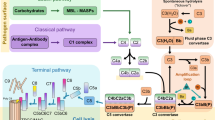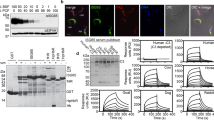Abstract
Aggregated trypanosome masses that had formed in the region of equivalence in the absence of complement were readily dissociated by complement. Complement-mediated dissociation of the clumped trypanosomes in the area of equivalence released approximately 50% of the previously bound surface antigens. These antigens were capable of rebinding to new IgG antibody. Experiments indicated that complement deposition altered the bivalent IgG antibody in the immune complex into a univalent form. The occurrence of such an event in the presence of complement provides a great advantage to the infected host in the killing of pathogens in vivo, as it enables a greater number of antibodies to attach to surface antigens and subsequently initiate complement activity.
Similar content being viewed by others
References
Allen R, Isliker H (1974) Studies on the complement-binding site for rabbit immunoglobulin G: II. The reaction of rabbit IgG and its fragment with C1q. Immunochemistry 11:243–248
Ballow M, Cochrane CG (1969) Two anticomplementary factors in cobra venom: haemolysis of guinea-pig erythrocytes by one of them. J Immunol 103:944–952
Casali P, Lambert PH (1979) Purif cation of soluble immunecomplexes from serum using polymethylmethacrylate beads coated with conglutinin or C1q. Application to the analysis of the components of in vitro formed immune complexes and of immune complexes occurring in vitro during leishmaniasis. Clin Exp Immunol 37:295–309
Connel G, Porter RR (1971) A new enzymatic fragment (Fab) of rabbit immunoglobulin G. Biochem J 124:53
Gross GAM (1978) Antigenic variation in trypanosomes. Proc R Soc Lond [Biol] 202:55–72
Czop J, Nussenzweig V (1976) Studies on the mechanism of solubilization of immune precipitates by serum. J Exp Med 143:615–630
Dusanic DC (1975)Trypanosoma musculi: infections in complement-deficient mige. Exp Parasitol 37:205–210
Edelman GM (1970) The covalent structure of a human rG-immunoglobulin: XI. Functional implications. Biochemistry 9:3197–3205
Ghebrehiwet BRG, Medicus RG, Muller-Eberhard HJ (1979) Potentiation of antibody-dependent cell-mediated cytotoxicity by target cell-bound C3b. J Immunol 123:1285–1288
Grant DB (1968) Observations of the precipitation reaction in a double antibody immunoassay for insulin. Acta Endocrinol 59:139–149
Inoki S, Kitaura T, Nakabayashi T, Kurogochi H (1952) Studies on the immunological variations inTrypanosoma gambiense: I. A new variation system and a new experimental method. Med J Osaka Univ 3:357–371
Jones TC, Yeh S, Hirsch JD (1972) Studies on attachment and ingestion phases of phagocytosis ofMycoplasma pulmonis by mouse peritoneal macrophage. Proc Soc Exp Biol Med 139:464–470
Kehoe JM, Fougereau M (1969) Immunoglobulin peptide with complement fixing activity. Nature 224:1212–1213
Lange DE, Lysenko MG (1960) In vitro phagocytosis ofTrypanosoma lewisi by rat exudative cells. Exp Parasitol 10:39–42
Lanham SM, Godfrey DG (1970) Isolation of salivarian trypanosome from man and other mammals using DEAE-cellulose Exp Parasitol 28:521–534
Lay WH, Nussenzweig V (1968) Receptors for complement on leukocytes. J Exp Med 128:991–1009
Mayer MM (1961) Experimental immunology, 2nd edn. Charles C Thomas, Springfield, Illinois
Miller GW, Nussenzweig V (1975) A new complement function solubilization of antigen-antibody aggregates. Proc Natl Acad Sci USA 72:418–422
Miller JK (1965) Variation of the soluble antigens ofTrypanosoma brucel. Immunology 9:521–528
Morgan CR, Sorenson RL, Lazarow A (1964) Further studies of an inhibitor of the two antibody immunoassay system. Diabetes 13:579–584
Nelson RA Jr (1953) The immune adherence phenomenon. Scjence 118:733–737
Osaki H (1959) Studies on the immunological variation inTrypanosoma gambiense (serotype and the mode of relapse). Biken J 2:113–127
Patton CL (1972)Trypanosoma lewisi: influence of seera and peritoneal exudate cells. Exp Parasitol 31:370–377
Perlmann H, Perlmann P, Schreiber RD, Muller-Eberhard H (1981) Investigation of target cell-bound C3 bi and C3d with human lymphocyte receptors. J Exp Med 153:1592–1603
Rabinovitch M (1967) Studies of the immunoglobulins which stimulate the ingestion of glutaraldehyde-treated red cells attached to macrophages. J Immunol 99:1115–1120
Ross GD, Polly JM (1974) Human lymphocyte and granulocyte receptors for the fourth component of complement (C4) and the role of granulocyte receptors in phagocytosis. Fed Proc 33:759
Schifferli JA, Bartolotti SR, Peters DK (1980) Inhibition of immune precipitation by complemen. Clin Exp Imnunol 42:387–394
Seed JR (1963) The characterization of antigens isolated fromTrypanosoma rhodesiense. J Parasitol 10:380–389
Seed JR, Gam AA (1966a) The properties of antigens fromTrypanosma gambiense. J Parasitol 52:395–398
Seed JR, Gam AA (1966b) Passive immunity to experimental trypanosomiasis. J Parasitol 52:1134–1140
Seed JR, Cornille RL, Risay EL, Gam AA (1969) The presence of agglutinating antibody in the IgM immunoglobulin reaction of rabbit antiserum during experimental African trypanosomiasis. Parasitology 59:283–292
Soltys MA (1957) Immunity in trypanosomiasis: II. Agglutination reaction with African trypanosomes. Parasitology 47:390–395
Takahashi M, Tack BF, Nussenzweig V (1977) Requirements for the sllubilization of immune aggregates by complement. Assembly of a factor B-dependent C3-convertase on the immune complexes. J Exp Med 145:86–100
Takayanagi T, Enriquez GL (1973) Effect of the IgG and IgM immunoglobulins inTrypanosoma gambiense infections in mice. J Parasitol 59:644–647
Takayanagi T, Nakatake Y, Kato H (1977)Trypanosoma gambiense: inaccessibility as a factor in agglutination and binding to host macrophages. Exp Parasitol 43:196–202
Takayanagi T, Kawaguchi H, Yabu Y, Itoh M, Appawu MA (1987) Contribution of the complement system to antibody-mediated binding ofTrypanosoma gambiense to macrophages. J Parasitol 73:333–341
Uhr JW (1965) Passive sensitization of lymphocytes and macrophages by antigen-antibody complexes. Proc Natl Acad Sci USA 54:1599–1606
Uhr JW, Philips JM (1966) In vitro sensitization of phagocytes and lymphocytes by antigen-antibody complexes. Ann NY Acad Sci 129:793–797
Watkins JF (1964) Observations on antigenic variation in a strain ofTrypanosama brucei growing in mice. J Hyg (Cambridge) 62:69–80
Weitz B (1960) The properties of some antigens ofTrypanosma brucei. J Gen Microbiol 23:589–600
Author information
Authors and Affiliations
Rights and permissions
About this article
Cite this article
Takayanagi, T., Kawaguchi, H., Yabu, Y. et al. Dissociation of IgG antibody-mediated clumps ofTrypanosoma brucei gambiense by complement. Parasitol Res 77, 645–650 (1991). https://doi.org/10.1007/BF00928677
Accepted:
Issue Date:
DOI: https://doi.org/10.1007/BF00928677




